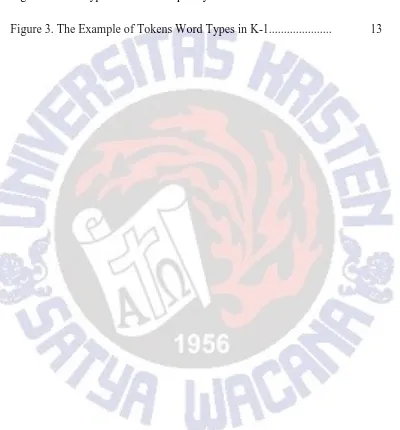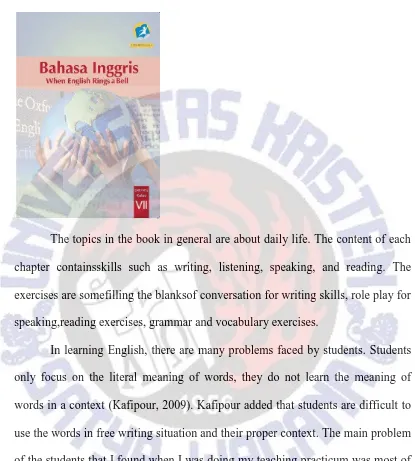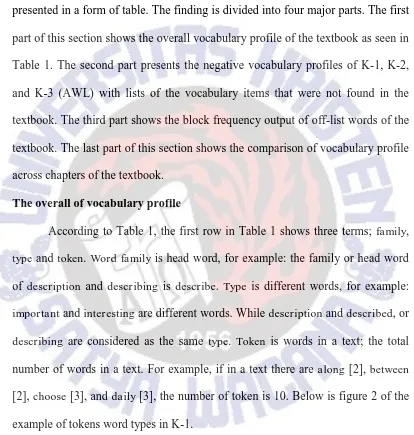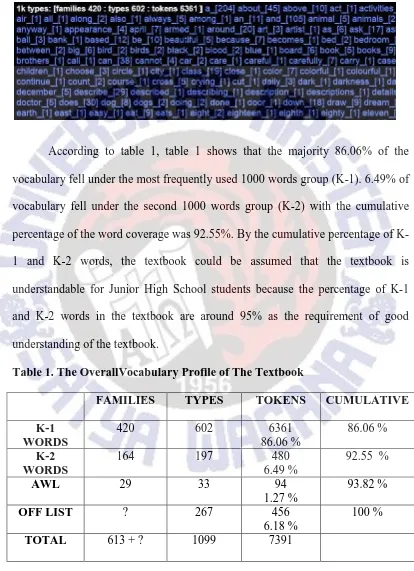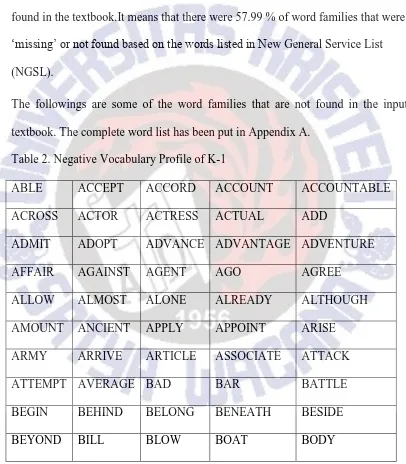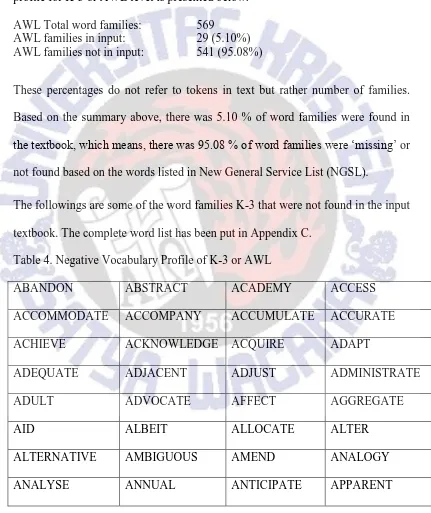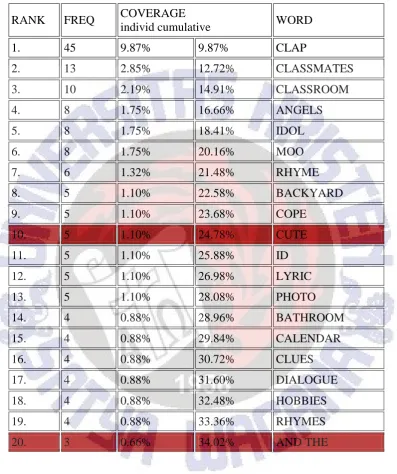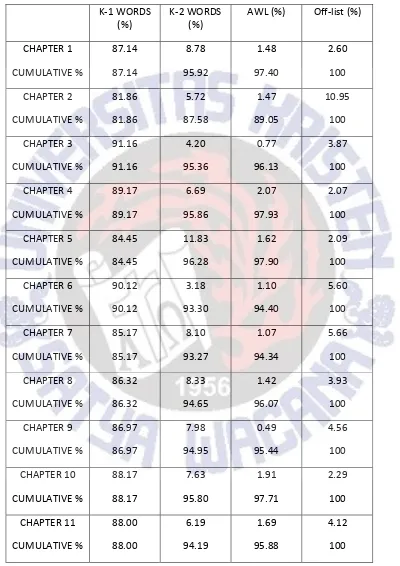i
VOCABULARY PROFILE OF ENGLISH TEXTBOOK USED
IN GRADE 7 IN SALATIGA STATE JUNIOR HIGH SCHOOL7
THESIS
Submitted in Partial Fulfillment of The Requirements for The Degree of Sarjana Pendidikan
Ika Runtiana Setyaningrum 112012154
ENGLISH LANGUAGE EDUCATION PROGRAM
FACULTY OF LANGUAGE AND LITERATURE
SATYA WACANA CHRISTIAN UNIVERSITY
SALATIGA
ii
VOCABULARY PROFILE OF ENGLISH TEXTBOOK USED
IN GRADE 7 IN SALATIGA STATE JUNIOR HIGH SCHOOL7
THESIS
Submitted in Partial Fulfillment of The Requirements for The Degree of Sarjana Pendidikan
Ika Runtiana Setyaningrum 112012154
ENGLISH LANGUAGE EDUCATION PROGRAM
FACULTY OF LANGUAGE AND LITERATURE
SATYA WACANA CHRISTIAN UNIVERSITY
SALATIGA
v
VOCABULARY PROFILE OF ENGLISH TEXTBOOK USED
IN GRADE 7 IN SALATIGA STATE JUNIOR HIGH SCHOOL7
THESIS
Submitted in Partial Fulfillment of The Requirements for The Degree of Sarjana Pendidikan
Ika Runtiana Setyaningrum 112012154
Approved by
Prof. Dr. Gusti Astika, M. A Yustinus Calvin Gai Mali, M.Hum
vi
COPYRIGHT STATEMENT
This thesis contains no such material as has been submitted for examination in any course or accepter for the fulfillment of any degree or diploma in any university. To the best of my knowledge and my belief, this contains no material previously published or written by any other person except where due reference is made in the text.
Copyright@2016. Ika Runtiana Setyaningrum and Prof. Dr. Gusti Astika, M. A All right reserved. No part of this thesis may be produced by any means without the permission of at least of one the copyright owners or English Language Education Program, Faculty of Language and Literature, Satya Wacana Christian University, Salatiga.
vii
PUBLICATION AGREEMENT DECLARATION As a member of Satya Wacana Christian University (SWCU) academic community, I verify that:
Name : Ika Runtiana Setyaningrum Student ID Number : 112012154
Study Program : English Language Education Program Faculty : Language and Literature
Kind of Work : Undergraduate Thesis
In developing my knowledge, I agree to provide SWCU with a non-exclusive royalty free right for my intellectual property and the content as there in entitled: Vocabulary Profile of English Textbook Used in Grade 7 in Salatiga State Junior High School 7
along with any pertinent equipment
With a non-exclusive royalty free right, SWCU maintains the right to copy, reproduce, print, publish, post, display, incorporate, store in or scan into a retrieval system or database, transmit, broadcast, barter, or sell my intellectual property, in whole or in part without my express written permission, as long as my name is still included as the writer.
The declaration is made according to the best of my knowledge.
Made in: Salatiga Date:
Verified by signed
Ika Runtiana Setyaningrum Approved by:
Prof. Dr. Gusti Astika, M. A Yustinus Calvin Gai Mali, M.Hum
viii Table of content
Cover page... i
Appoval page... ii
Copyright statement... iii
Publication agreement declaration... iv
Table of content... v
List of tables... vii
List of figures... viii
Abstract... 1
A.Introduction... 1
B.Literature Review... 4
1.Teaching Vocabulary... 4
2.Learning Vocabulary... 5
3.Vocabulary Profiler... 6
4.Previous Study about Vocabulary Profile... 7
C.The Study... 9
1.Method of research... 9
2.Samples... 9
3.Research Instrument... 9
4.Data Collection... 10
ix
D.Findings and Discussion... 12
The overall of vocabulary profile... 12
Negative vocabulary profiles of the textbook... 14
Negative vocabulary profile of K1... 14
Negative vocabulary profile of K2... 16
Negative vocabulary profile of K3 or AWL... 17
Block Frequency output of off-list words... 18
Comparison of vocabulary frequency across chapters of the textbook 19
Comparison of chapter 2 vs. Chapter 3... 21
Comparison of chapter 5 vs. Chapter 6... 23
List of 100 Words of K-1... 24
List of 100 Words of K-2... 25
Conclusion... 26
Acknowledgement... 28
References... 29
Appendixes... 32
Appendix A... 32
Appendix B... 36
Appendix C... 41
Appendix D... 45
Appendix E... 55
x List of Tables
Table 1. The overall of vocabulary profile... 13
Table 2. Negative Vocabulary Profile of K-1... 15
Table 3. Negative Vocabulary Profile of K-2... 16
Table 4. Negative Vocabulary Profile of K-3 or AWL... 17
Table 5. Block Frequency Output of Off-List Words... 19
Table 6. Comparison of Word Frequency Level... 20
Table 7. Shared and Unique Words in Chapter 2 and Chapter 3... 22
Table 8. Shared andUnique Words in Chapter 5 and Chapter 6... 23
Table 9. List of 100 Words of K-1... 24
xi List of Figures
1
VOCABULARY PROFILE OF ENGLISH TEXTBOOK USED IN GRADE 7 IN SALATIGA STATE JUNIOR HIGH SCHOOL7
Ika Runtiana Setyaningrum
Abstract
Vocabulary is one important element in learning English. Especially in Indonesia, most of students have difficulty in understanding the meaning of vocabulary, producing vocabulary, and using vocabulary in appropriate context. This study aims to analyze the vocabulary profile of English textbook used in grade 7 in Salatiga State Junior High School 7, produce list of vocabulary that are not covered in the textbook, and produce the token (word) recycling index of the textbook. This study used all contents of the textbook as the sample. The analysis used an electronic tool named The Compleat Lexical Tutor, v.4. There are 86.06% of K-1 and 6.49% of K-2 that means the textbook is understandable for students. The 7.45% of the rest words means that students need effort to study. There are 57.99% of K-1, 83.47% of K-2, and 95.08% of academic words that were not found in the textbook. The comparison analysis of chapter 2 and chapter 3 showed that there are 56.80% similar words in those chapters. There are 58.29% similar words in chapter 5 and chapter 6.
Keywords: Vocabulary, Vocabulary profile, Learning, Students, Words, Understanding, Textbook.
A. Introduction
2 Figure 1. Cover of The Textbook
The topics in the book in general are about daily life. The content of each chapter containsskills such as writing, listening, speaking, and reading. The exercises are somefilling the blanksof conversation for writing skills, role play for speaking,reading exercises, grammar and vocabulary exercises.
3
One tool that can help students to increase vocabulary knowledge is vocabulary profile. The vocabulary profilecan help teachers and students to choose which vocabulary is appropriate for them in teaching and learning. According to Schuemann and Benz (2004), in A web-based vocabulary profiler for Chinese language teaching and research (as cited in Da, 2006, p.1) said that
the vocabulary profile is a very valuable resource when teachers and students prepare materials and make decision how to learn appropriate vocabulary.
There were three research questions of the study:
1. What is the profile of the vocabulary in the textbook
2. What is the proportion of vocabulary that is not covered in the textbook?
3. What is the token (word) recycling index of the textbook?
4
B. Literature Review
This section presents theories that used in this study. There are four parts in this section. There are teaching vocabulary, learning vocabulary, vocabulary profile, and the previous study about vocabulary profile.
1. Teaching vocabulary
Vocabulary is one important element in learning English. According to Wehmeier, McIntosh,Turnbull, and Ashby, in The teaching of EFL Vocabulary in the Indonesian Context: The State of The Art (as cited in Cahyono and Widiati,
2008, p.1)“vocabulary is all words in a language”. Jianbin, Yuedong, and Ying (2007) added that word is the smallest meaningful linguistic unit that can stand by itself. As vocabulary is one important element in learning English, teachers and students who teach and learn vocabulary, have to acquire as much vocabulary as possible in English. Pikulski and Pempleton (2004) defined that teaching vocabulary is to facilitate students to understand the text. According to Nation (2001), teaching vocabulary is one of efficient ways to develop learners‟ vocabulary knowledge. Nation added that teaching vocabulary only takes a few
parts in developing students‟ vocabulary knowledge, but it becomes an important
5 2. Learning vocabulary
Besides teaching vocabulary, students play their roles in learning vocabulary. According to Hunt and Beglar, in The teaching of EFL Vocabulary in the Indonesian Context: The State of The Art (as cited in Cahyono and Widiati,
6 3. Vocabulary profile
According Astika (2014), vocabulary profile is a program designed by Laufer and Nation (1995) which has functions to determine lexical richness (lexical difficulty). Vocabulary profile can help the teacher to categorize which vocabulary is used to teach students. Vocabulary profile is used to differentiate which vocabulary is appropriate to be taught to students at the beginner, intermediate, and advance level. Vocabulary profile helps the teacher to teach students step by step the vocabulary from high to low frequency words. According to Nation (2001), vocabulary is divided into four types such as high-frequency words known as K1 (1-1000 words), K2 (1001-2000 words), academic words, technical words, and low-frequency words. Nation added that high-frequency vocabulary is very useful for learners, because the words are used by the teachers in explaining the materials in class. Academic vocabulary is specialized language of academic settings used by learners to learn target language. Technical vocabulary focuses on a particular purpose for learners to learn target language. The last is low-frequency vocabulary is the words that are rarely used in teaching learning process. Schuemann and benz (2004), in A web-based vocabulary profiler for Chinese language teaching and research (as cited
7
teacher can choose which words are appropriate to be taught for students in the different levels of study. Besides, vocabulary profile helps students to memorize and understand what vocabulary is given by the teacher. It also helps them to choose which vocabulary is appropriate to produce when they are asked to speak or used it in the real communication.
4. Previous study about vocabulary profile
8
9 The Study 1. Method of research
This study used a descriptive method to analyze the data. According to Rivera (2007) descriptive method is used to identify facts of research and it includes the description, analysis, and interpretation of data collection. In this study, English textbook for Junior High School was analyzed whether the vocabulary falls into the category of high frequency known as K1 word (1-1000 words) and K2 word (1001-2000) or academic words.
2. Samples
The sample of this study was the Junior High School textbook used for grade 7.
The title of the book is „When English Rings A Bell‟. The book has 11 chapters
with 224 pages. For validity purpose, this analysis took all contents of the book. 3. Research Instrument
10
Figure 2. Four Types of Word Frequency in Different Color
According to figure 1, the blue color belongs to K-1 words. The green color belongs to K-2 words. The red color belongs to academic words. The yellow color belongs to off-list words.
4. Data collection
For data collection, the first step was selecting words from the book. The second step was copying the selected words from the pdf file of the book into the document file. All lexical items had to be selected except name of persons, name of towns, number, phonetic transcript, and to be-verbs. Therefore, only the lexical items were analyzed using the vocabulary profiler.
5. Data Analysis
11
12
C. Findings and Discussion
This section presents the result of the analysis. There were 7.391 words analyzed using The Compleat Lexical Tutor, v.4. The vocabulary profile is presented in a form of table. The finding is divided into four major parts. The first part of this section shows the overall vocabulary profile of the textbook as seen in Table 1. The second part presents the negative vocabulary profiles of K-1, K-2, and K-3 (AWL) with lists of the vocabulary items that were not found in the textbook. The third part shows the block frequency output of off-list words of the textbook. The last part of this section shows the comparison of vocabulary profile across chapters of the textbook.
The overall of vocabulary profile
According to Table 1, the first row in Table 1 shows three terms; family, type and token. Word family is head word, for example: the family or head word
of description and describing is describe. Type is different words, for example: important and interesting are different words. While description and described, or
13
Figure 3. The Example of Tokens Word Types in K-1
According to table 1, table 1 shows that the majority 86.06% of the vocabulary fell under the most frequently used 1000 words group (K-1). 6.49% of vocabulary fell under the second 1000 words group (K-2) with the cumulative percentage of the word coverage was 92.55%. By the cumulative percentage of K-1 and K-2 words, the textbook could be assumed that the textbook is understandable for Junior High School students because the percentage of K-1 and K-2 words in the textbook are around 95% as the requirement of good understanding of the textbook.
Table 1. The OverallVocabulary Profile of The Textbook
FAMILIES TYPES TOKENS CUMULATIVE
K-1 WORDS
420 602 6361
86.06 %
86.06 % K-2
WORDS
164 197 480
6.49 %
92.55 %
AWL 29 33 94
1.27 %
93.82 %
OFF LIST ? 267 456
6.18 %
100 %
14
Hirsch (2003), in Learning vocabulary in another language stated that an understanding of 90-95% of the words is necessary for comprehension.1.27% of vocabulary fell under the academic words (AWL). Academic words are words that are commonly used in academic texts. We need to select whether the academic words that amounted to 94 words used in the textbook need to be introduced to the students in Junior High Schools. There were 459 words fell under off-list. Off list words are those words that did not include into other categories. This off-list word should not be ignored in teaching, because students at this level need to know about the vocabulary. Then, teachers have to select for useful words in this category. The rest percentage of AWL and off-list words were 6.18%, it means that students still need effort to study.
Negative vocabulary profiles of the textbook
The section below presents the description of negative vocabulary profiles of the textbook. Negative vocabulary is vocabulary items that are not found in the textbook. The list of negative K-1 words below is useful for teachers in selecting vocabulary items that students may find useful to develop their vocabulary knowledge.
Negative vocabulary profile of K1
15 1k Total word families: 964
1k families in input: 406(42.12%) 1k families not in input: 559 (57.99%)
These percentages do not refer to tokens in text but rather number of families. Based on the summary above, there were 42.12 % of word families that were found in the textbook.It means that there were 57.99 % of word families that were
„missing‟ or not found based on the words listed in New General Service List (NGSL).
The followings are some of the word families that are not found in the input textbook. The complete word list has been put in Appendix A.
Table 2. Negative Vocabulary Profile of K-1
ABLE ACCEPT ACCORD ACCOUNT ACCOUNTABLE
ACROSS ACTOR ACTRESS ACTUAL ADD
ADMIT ADOPT ADVANCE ADVANTAGE ADVENTURE
AFFAIR AGAINST AGENT AGO AGREE
ALLOW ALMOST ALONE ALREADY ALTHOUGH
AMOUNT ANCIENT APPLY APPOINT ARISE ARMY ARRIVE ARTICLE ASSOCIATE ATTACK
ATTEMPT AVERAGE BAD BAR BATTLE
BEGIN BEHIND BELONG BENEATH BESIDE
16 Negative Vocabulary profile of K2
This sectionpresents all the word families (=head words) from the K-2 level that were not found in the textbook. The summary of negative vocabulary profile for K-2 level is presented below.
2k Total word families: 986
2k families in input: 164 (16.63%) 2k families not in input: 823 (83.47%)
These percentages do not refer to tokens or number of words in the textbooks but rather number of word families. Based on the summary above, there were 16.63 % of word families that were found in the textbooks.It means there were 83.47 % of
word families were „missing‟ or not found based on the words listed in New General Service List (NGSL).
The followings are some of the word families K-2 that were not found in the input textbook. The complete word list has been put in Appendix B.
Table 3. Negative Vocabulary Profile of K-2
ABROAD ABSENCE ABSENT ABSOLUTE ABSOLUTELY
ACCIDENT ACCUSE ACCUSTOM ACHE ADMIRE
ADVERTISE ADVICE AEROPLANE AFFORD AGRICULTURE
AHEAD AIM AIRPLANE ALIKE ALIVE
ALTOGETHER AMBITION AMUSE ANGER ANGLE
ANNOY ANXIETY APART APPLAUD APPLAUSE
APPLE APPROVE ARCH ARGUE ARRANGE
17 Negative vocabulary profile of K3 or AWL
This sectionpresents all the word families (=head words) from the K-3 or AWL level that were not found in the textbook. The summary of negative vocabulary profile for K-3 or AWL level is presented below.
AWL Total word families: 569
AWL families in input: 29 (5.10%) AWL families not in input: 541 (95.08%)
These percentages do not refer to tokens in text but rather number of families. Based on the summary above, there was 5.10 % of word families were found in
the textbook, which means, there was 95.08 % of word families were „missing‟ or not found based on the words listed in New General Service List (NGSL).
The followings are some of the word families K-3 that were not found in the input textbook. The complete word list has been put in Appendix C.
Table 4. Negative Vocabulary Profile of K-3 or AWL
ABANDON ABSTRACT ACADEMY ACCESS
ACCOMMODATE ACCOMPANY ACCUMULATE ACCURATE
ACHIEVE ACKNOWLEDGE ACQUIRE ADAPT
ADEQUATE ADJACENT ADJUST ADMINISTRATE
ADULT ADVOCATE AFFECT AGGREGATE
AID ALBEIT ALLOCATE ALTER
ALTERNATIVE AMBIGUOUS AMEND ANALOGY
18 Block frequency output of off-list words.
19
Table 5. Block Frequency Output of Off-List Words
RANK FREQ COVERAGE
individ cumulative WORD
1. 45 9.87% 9.87% CLAP
2. 13 2.85% 12.72% CLASSMATES
3. 10 2.19% 14.91% CLASSROOM
4. 8 1.75% 16.66% ANGELS
5. 8 1.75% 18.41% IDOL
6. 8 1.75% 20.16% MOO
7. 6 1.32% 21.48% RHYME
8. 5 1.10% 22.58% BACKYARD
9. 5 1.10% 23.68% COPE
10. 5 1.10% 24.78% CUTE
11. 5 1.10% 25.88% ID
12. 5 1.10% 26.98% LYRIC
13. 5 1.10% 28.08% PHOTO
14. 4 0.88% 28.96% BATHROOM
15. 4 0.88% 29.84% CALENDAR
16. 4 0.88% 30.72% CLUES
17. 4 0.88% 31.60% DIALOGUE
18. 4 0.88% 32.48% HOBBIES
19. 4 0.88% 33.36% RHYMES
20. 3 0.66% 34.02% AND THE
20 Table 6. Comparison of Word Frequency Level
21
According to Table 6 above, the differences of K-1, K-2, AWL, and Off-list words across chapters in the textbook were not very significant. I can say that the percentage of the vocabulary in each frequency level in the chapters was relatively similar. However, students may have difficulty to learn the textbook because AWL words are usually used in academic texts. The percentage of K-1 and K-2 words also provide information about difficulty of understanding the textbook as the percentage of K-1 and K-2 words in the textbook are around 95% as the requirement of good understanding of the textbook.
Text comparison across chapter of the book Comparison of chapter 2 vs. Chapter 3
22
Table 7. Shared and Unique Words in Chapter 2 and Chapter 3 Unique to first
172 tokens
016. introduce 3 020. wednesday 6 002. afternoon 2
23 Comparison of Chapter 5 vs Chapter 6
The second comparison was chapter 5 and chapter 6. Those chapters were compared because chapter 5 had the highest percentage of K-2. Besides, chapter 6 had the lowest percentage of K-2. The comparison analysis presents that the token recycling index was 58.29%. It indicates that there were 58.29 % similar words inchapter 5 and chapter 6. There were 32.79% unique words in the chapter 6. Table 8 below shows the similar and unique words in chapter 5 and chapter 6.The complete table has been put in Appendix 6
Table 8. Shared andUnique Words in Chapter 5 and Chapter 6 Unique to first
147 tokens 015. butterfly 1
24
List of 100 Words of K-1
According to findings and discussion parts above, I listed 100 words of K-1 of the textbook. Table 9 belowshows the list of K-100 words of K-K-1 in the textbook. This list is useful for teachers as an information and a referenceabout which vocabulary that are necessary to teach students in grade 7. It is also useful for students as their guidance about which vocabulary that they have to learn and understand.
Table 9. List of 100 Words of K-1
ABOUT ACTIVITY ALWAYS ALONG
ANIMAL AROUND ASK AWAY
BASED BEAUTIFUL BECAUSE BECOME
BELOW BEST BOOK BOX
BRING CALL CAN CAREFULLY
CHANGE CHOOSE CLASS CONTINUE
DAILY DESCRIBE DIFFERENT DO
DRAW DREAM DRINK EAT
EVERY EXAMPLE EXPLAIN EXPRESS
FAMILY FEEL FILL FIND
FOOD FRIEND GAME GET
GIVE GO GOOD GROUP
HAVE HELP HOME HOW
JANUARY JULY JUNE KEEP
KIND KNOW LEARN LIKE
LISTEN LOOK MAKE MANY
MENTION NAME NEED NOTE
OBJECT OBSERVE OPINION PEOPLE
PICTURE PLEASE QUESTION READ
RIGHT ROOM SAY SCHOOL
STUDY TABLE TEACHER THING
THINK UNDERSTAND USE USUALLY
VERY VISIT WHAT WHEN
WILL WORD WORK WRITE
25
List of 100 Words of K-2
According to findings and discussion parts above, I listed 100 words of K-2 of the textbook. Table 10 below shows the list of 100 words of K-K-2 in the textbook. This list is useful for teachers as an information and a reference about which vocabulary that are necessary to teach students in grade 7. It is also useful for students as their guidance about which vocabulary that they have to learn and understand.
Table 10. List of 100 Words of K-2
AFRAID ALOUD APOLOGIZE APOLOGY
ATTENTION BAG BATH BIRTH
BITE BOTTLE BOWL BUCKET
CARD CHAIR CLEAN CLEVER
COLLECT CONVERSATION CORRECT DESK
DICTIONARY DIRTY DISCUSS EDUCATION
EXAMINE EXCUSE FEATHER FRAME
FRUIT FRY GARAGE GRAMMAR
GREET GUESS GUIDE HAIR
HEALTH HOSPITAL HUT IMPROVE
INFORMATION JOKE KITCHEN KNIFE
LADDER LAMP LESSON LIKE
LOT LUCKY MAIL MAP
MATCH MESSAGE NICE NOSE
NOUN NURSE ORANGE PACK
PAIR PARENT PAIR PARK
PATIENT PERFORM PRACTICE PRONOUN
PROUD PUSH QUIET REFER
REGULAR REPEAT RESTAURANT RICE
SCALE SENTENCE SHEET SHOWER
SINK SKIN SMOOTH SORRY
SPELL STICK STRAIGHT SUITABLE
TAIL TALL THANK THICK
THIN TITTLE UNCLE VERB
26 Conclusion
The vocabulary profile is really useful to help teachers and students in junior high school in the learning vocabulary. The aims of the study are to profile the vocabulary used in the textbook in Junior High School,to produce list of vocabulary that are not covered in the textbook, and to produce the token (word) recycling index of the textbook.
This study has produced three major results. First, there are 86.06% of K-1 and 6.49% of K-2 words in textbook that could be assumed that the textbook is understandable for Junior High School students, but the rest7.45% of the wordsrequire students‟ effort to study. Second, there are 57.99% of K-1, 83.47% of K-2, and 95.08% of academic words that were not found in the textbook. By that analysis, it is useful for teachers to select vocabulary items that students may find useful to develop their vocabulary knowledge. Third, the comparison analysis was done for chapter 2 and chapter 3, and chapter 5 and chapter 6. The comparison analysis of chapter 2 and chapter 3 shows that there are 56.80% words in those chapters that are similar. There are 58.29% words that are similar in chapter 5 and chapter 6.
However, this study still has limitation, that is: it only used one textbook to analyze. Having more than one book to analyze would be more beneficial for the research about teaching and learning vocabulary.
27
28
Acknowledgement
This study would not have been completed supports and help from many people. First of all, I would like to thank to Allah SWT for his blessing and guidance in finishing this study. I would like to express my sincere gratitude to my supervisor, Prof. Dr. Gusti Astika, M.A. for his invaluable patience and guidance during the completion of this study, and also my examiner, Yustinus Calvin Gai Mali, M.Hum for his suggestion and guidance for this thesis.
29 References
Ardyny, A. G. K. (2014). Vocabulary profile of introduction to language education textbook. Unpublished undergraduate‟s thesis, Satya Wacana
Christian University, Salatiga, Indonesia.
Astika, G. (2014). Profiling the vocabularyof news texts as capacity building for language teachers. Indonesia Journal of Applied Linguistics, 4 (2), 257-266
Brabham, E., Buskist, C., Henderson, S. C., Paleologos, T., & Baugh, N. (2012). Flooding vocabulary gaps to accelerate word learning. International Reading Association, 65 (8), 523-533.
Cahyono, B. M, & Widiati, U. (2008). The teaching of efl vocabulary in the indonesian context: the state of the art. TEFLIN Journal, 19(1), 1-17. Carten, J.M. (2007). Teaching vocabulary. Cambridge: Cambridge University
Press.
Da, J. (2006). A web-based vocabulary profiler for Chinese language teaching and research. Middle Tennessee State University, 1-6.
Jianbin, H., Yuedong, S., & Ying, X. (2007). On the vocabulary size for chinesse english learners. Polyglossia, 13, 1-11.
Jusuf, Y.A. (2014). Vocabulary profile in english textbooks used in satya wacana junior high school. Unpublished undergraduate‟s thesis, Satya Wacana
30
Kafipour, R., & Naveh, M. H. (2011). Vocabulary learning strategies and their contribution to reading comprehension of EFL undergraduate students in Kerman Province. European Journal of Social Sciences, 23 (4), 626-647. Kieffer, M.J., & Lesaux, M.K. (2007). Breaking down words to build meaning:
morphology, vocabulary and reading comprehension in the urban classroom. The reading teacher, 61 (2), 134-144.
Liu, S.-H.-J., Lan, Y.-J., & Ho, C.-Y.-Y. (2014). Exploring the Relationship between Self-Regulated Vocabulary Learning and Web-Based Collaboration. Educational Technology & Society, 17 (4), 404–419.
Morris, L., & Cobb, T. (2004). Vocabulary profiles as predictors of the academic performance of Teaching English as a second language trainees. Elsevier.com, 32(1), 75-87.
Nation, I, S, P. (2001). Learning vocabulary in another language. Cambrigde: Cambridge University Press.
National Reading Panel. (2000). Teaching children to read: an evidence-based assessment of the scientific research literature on reading and it’s on
implication for reading instruction, Oregon, February 2000.Oregon,
National Reading Panel: Author.
Pikulski, J. J., & Templeton, S. (2004). Teaching and developing vocabulary: key to long-term reading success. Houghton Mifflin Company, 1-12.
31
Schmitt, N., & Schmitt, D. (2014). A reassessment of frequency and
vocabulary size in L2 vocabulary teaching. Language Teaching, 47 (4), 484-503.
Topcu, N., & Kirmizi, O. (2014). Vocabulary learning strategies of turkish english foreign learners students at karabuk university. Ataturk University Sosyal Bilimler Enstitusu Dergisi, 18 (3),217-232.
Treffers-Daller, J. and Milton, J. (2013). Vocabulary size revisited: the link between vocabulary size and academic achievement. Applied Linguistics Review, 4 (1), 151-172.
32 Appendixes Appendix A
Negative Vocabulary Profile of K1
ABLE ACCEPT ACCORD ACCOUNT
ACCOUNTABLE ACROSS ACTOR ACTRESS
ACTUAL ADD ADMIT ADOPT
ADVANCE ADVANTAGE ADVENTURE AFFAIR
AGAINST AGENT AGO AGREE
ALLOW ALMOST ALONE ALREADY
ALTHOUGH AMOUNT ANCIENT APPLY
APPOINT ARISE ARMY ARRIVE
ARTICLE ASSOCIATE ATTACK ATTEMPT
AVERAGE BAD BAR BATTLE
BEGIN BEHIND BELONG BENEATH
BESIDE BEYOND BILL BLOW
BOAT BODY BOTH BRANCH
BREAD BREAK BRIDGE BRIGHT
BROAD BUILD BURN BUSINESS
BUT BUY BY CAPITAL
CAPTAIN CASTLE CAUSE CENTRE
CERTAIN CHANCE CHARGE CHIEF
CHURCH CLAIM CLEAR CLOUD
COAL COAST COIN COLD
COLLEGE COLONY COMMAND COMMITTEE
COMMON COMPANY CONCERN CONSIDER
CONTAIN CONTROL CORN COST
COTTON COULD COUNCIL COUNTRY
COURT COVER CROWD CROWN
CURRENT DANGER DEAD DEAL
DEAR DECIDE DECLARE DEEP
DEFEAT DEGREE DEMAND DEPARTMENT
DEPEND DESERT DESIRE DESTROY
DETERMINE DEVELOP DIE DIFFICULT
DISCOVER DISTANCE DISTINGUISH DISTRICT
DIVIDE DOLLAR DOUBT DROP
DRY DUE DUTY EARLY
EFFECT EFFICIENT EFFORT EGG
EITHER ELECT ELSE EMPIRE
EMPLOY ENEMY ENJOY ENOUGH
33
EXCHANGE EXERCISE EXIST EXPECT
EXPENSE EXPERIENCE EXPERIMENT EXTEND
FACE FACT FACTORY FAIR
FAITH FALL FAMILIAR FAMOUS
FAR FAST FEAR FELLOW
FEW FIELD FIGHT FIGURE
FINISH FIRE FIT FIX
FLOOR FLOW FOREIGN FOREST
FORGET FORMER FORTH FORTUNE
FREE FULL GAIN GAS
GATE GATHER GENERAL GENTLE
GIFT GLAD GOD GO
GROUND GROW HALF HAND
HAPPEN HARDLY HEAD HEAT
HEAVEN HIGH HILL HISTORY
HONOUR HOT HOUR HOWEVER
HUMAN HUSBAND IDEA ILL
INCH INCLUDE INCREASE INDEED
INDUSTRY INFLUENCE INSTEAD IRON
JOIN JOINT JOINTED JOY
JUDGE JUST JUSTICE KEEP
KILL KING LACK LAKE
LAND LARGE LATTER LAUGH
LAUGHTER LAW LAY LEAD
LEFT LENGTH LESS LEVEL
LIE LIFE LIFT LIGHT
LIKELY LIMIT LIP LITERATURE
LOCAL LORD LOSE LOSS
LOW MACHINE MAIN MANNER
MANUFACTURE MARK MARKET MARRY
MASS MASTER MATERIAL MATTER
MAYBE MEASURE MEMORY MERE
METAL MIND MINER MINISTER
MINUTE MISTER MODERN MOMENT
MONEY MOON MORAL MOREOVER
MOTOR MOUNTAIN MOUTH MRS
MUST NATIVE NATURE NEAR
NECESSARY NECESSITY NEITHER NEVER
NEW NEWS NEWSPAPER NOBLE
NONE NOR NORTH NUMERICAL
NUMEROUS OFFER OFFICIAL OH
OIL ONCE ONLY OPEN
34
ORGANIZE OTHERWISE OUGHT OVER
OWE PAGE PARTICULAR PARTY
PAST PEACE PER PERHAPS
PERMIT PIECE PLAIN PLANT
POLITICAL POOR POPULAR POPULATION
POSITION POSSESS POUND POVERTY
POWER PREPARE PRESIDENT PRESS
PRESSURE PREVENT PRICE PRIVATE
PRODUCE PRODUCT PROFIT PROGRESS
PROOF PROPERTY PROPOSE PROVE
PROVISION PULL PURPOSE QUALITY
QUANTITY QUARTER QUEEN QUITE
RACE RAISE RANK RATE
RATHER READY REALISE RECEIPT
RECEIVE RECENT RECOGNIZE RECORD
RED REDUCE REFUSE REGARD
RELATIVE REMAIN REMARK REMEMBER
REPLY REPORT REPRESENT REPUBLIC
RESERVE RESPECT REST RESULT
RETURN RICH RIDE RING
RISE RIVER ROCK ROUGH
ROYAL SAFE SAIL SALE
SALT SAVE SCARCE SCENE
SEA SEASON SEAT SECRET
SECRETARY SEEM SELL SEND
SENSE SENSITIVE SEPARATE SERIOUS
SERVE SERVICE SETTLE SHADOW
SHAKE SHALL SHAPE SHINE
SHIP SHOOT SHORE SHOULDER
SIDE SIGHT SILVER SILENCE
SIMPLE SINCE SINGLE SITUATION
SKY SMILE SNOW SOCIETY
SOLDIER SON SORT SOUL
SOUND SOUTH SPACE SPEED
SPEND SPIRIT SPITE SPREAD
SPRING SQUARE STAGE STANDARD
START STATE STATION STEEL
STEP STOCK STONE STORE
STORY STRANGE STREET STRENGTH
STRIKE STRUGGLE SUBJECT SUBSTANCE
SUCCEED SUCH SUFFER SUGGEST
SUN SUPPLY SUPPOSE SURFACE
35
TAX TEAR TEMPLE TERM
TEST THAN THEREFORE THOUGH
THROW THUS TILL TON
TOP TOTAL TOUCH TOWARD
TRADE TRAIN TRAVEL TROUBLE
TRUE TRUST TRY UNION
UNITE UNIVERSITY UNLESS UNTIL
UPON VALLEY VALUE VARIETY
VARIOUS VESSEL VICTORY VIEW
VILLAGE VIRTUE VOICE VOTE
WAGE WAIT WALK WAR
WATCH WAVE WEALTH WELCOME
WEST WESTERN WHETHER WHOLE
WIDE WIFE WIN WIND
WINTER WISE WISH WITHIN
WITHOUT WOOD WORLD WOUND
36 Appendix B
Negative Vocabulary Profile of K2
ABROAD ABSENCE ABSENT ABSOLUTE
ABSOLUTELY ACCIDENT ACCUSE ACCUSTOM
ACHE ADMIRE ADVERTISE ADVICE
AEROPLANE AFFORD AGRICULTURE AHEAD
AIM AIRPLANE ALIKE ALIVE
ALTOGETHER AMBITION AMUSE ANGER
ANGLE ANNOY ANXIETY APART
APPLAUD APPLAUSE APPLE APPROVE
ARCH ARGUE ARRANGE ARREST
ARROW ARTIFICIAL ASH ASHAMED
ASIDE ASLEEP ASTONISH ATTEND
ATTRACT AUDIENCE AUTUMN AVENUE
AVOID AWAKE AWKWARD AXE
BABY BAGGAGE BAKE BALANCE
BAND BARBER BARE BARELY
BARGAIN BARREL BASIN BASKET
BATHE BAY BEAM BEAN
BEARD BEAST BEAT BEG
BEHAVE BEHAVIOUR BELL BELT
BEND BERRY BILLION BIND
BIT BITTER BLADE BLAME
BLESS BLIND BLOCK BOAST
BOIL BOLD BONE BORDER
BORROW BOTTOM BOUND BOUNDARY
BOW BRAIN BRASS BRAVE
BREAKFAST BREATH BREATHE BRIBE
BRICK BROADCAST BROWN BRUSH
BUNCH BUNDLE BURIAL BURST
BURY BUS BUSH BUSY
BUTTER BUTTON CAGE CAKE
CALCULATE CALM CAMERA CAMP
CANAL CAP CAPE CARRIAGE
CART CATTLE CAVE CENT
CENTIMETRE CENTURY CEREMONY CHAIN
CHALK CHARM CHEAP CHEAT
CHECK CHEESE CHEQUE CHEST
CHIMNEY CHRISTMAS CIVILISE CLAY
CLERK CLIFF CLIMB CLUB
37
COMB COMBINE COMMERCE COMPANION
COMPETE COMPETITION COMPLAIN COMPLICATE
COMPOSE CONFESS CONFIDENCE CONFUSE
CONGRATULA TE
CONNECT CONQUER CONSCIENCE
CONSCIOUS CONVENIENCE COOL COPPER
COPY CORK CORNER COTTAGE
COUGH COURAGE COWARD CRACK
CRASH CREAM CREATURE CREEP
CRIMINAL CRITIC CROP CRUEL
CRUSH CULTIVATE CURE CURIOUS
CURSE CURTAIN CURVE CUSHION
CUSTOM CUSTOMER DAMAGE DAMP
DANCE DARE DEAF DEBT
DECAY DECEIVE DECREASE DEED
DEER DEFEND DELICATE DELIGHT
DELIVER DESCEND DESERVE DESPAIR
DEVIL DIAMOND DIG DIP
DISAPPOINT DISCIPLINE DISEASE DISGUST
DISH DISMISS DISTURB DITCH
DIVE DONKEY DOT DOUBLE
DOZEN DRAG DRAWER DROWN
DRUM DULL DURING DUST
EAGER EARN EARNEST EASE
EDGE ELASTIC ELDER ELECTRIC
EMPTY ENCLOSE ENCOURAGE ENGINE
ENTERTAIN ENTIRE ENVELOPE ENVY
ESPECIAL ESSENCE ESSENTIAL EVIL
EXACT EXCELLENT EXCESS EXCITE
EXPLODE EXPLORE EXTRA EXTRAORDINA
RY
EXTREME FADE FAINT FALSE
FAN FANCY FASHION FASTEN
FAT FATE FAULT FEAST
FEVER FIERCE FILM FINGER
FIRM FLAG FLAME FLASH
FLAT FLAVOUR FLESH FLOAT
FLOOD FLOUR FOLD FOND
FOOL FORBID FORGIVE FORMAL
FORWARD FREEZE FREQUENT FRIGHT
FUN FUNERAL GALLON GAP
GAY GENEROUS GLORY GOAT
38
GRAM GRATEFUL GRAVE GREASE
GREED GREY GRIND GUARD
GUEST GUILTY GUN HABIT
HALL HAMMER HANDKERCHIE
F
HANDLE
HARBOR HARM HARVEST HASTE
HATE HAY HEAL HEAP
HESITATE HIDE HINDER HIRE
HIT HOLE HOLIDAY HOLLOW
HOLY HONEST HOOK HORIZON
HOST HOTEL HUMBLE HUNGER
HUNT HURRAH HURRY HURT
ICE IDEAL IDLE IMAGINE
IMITATE IMMEDIATE IMMENSE INFORMAL
INFORMALLY INN INQUIRE INSECT
INSIDE INSTANT INSTRUMENT INSULT
INSURE INTEND INTERFERE INTERNATION
AL
INTERRUPT INVENT INVITE INWARD
ISLAND JAW JEALOUS JEWEL
JOURNEY JUICE JUMP KEY
KICK KILOGRAM KILOMETRE KISS
KNEE KNEEL KNOCK KNOT
LAZY LEAF LEAN LEATHER
LEND LIBERTY LID LIMB
LIQUID LIST LITRE LOAD
LOAF LOAN LOCK LODGING
LOG LONE LOOSE LOUD
LOYAL LUMP LUNG MAD
MALE MANAGE MAT MATCH
MEAL MEANTIME MEANWHILE MEAT
MECHANIC MEDICINE MELT MEND
MERCHANT MERCY MERRY MESSENGER
METRE MILD MILL MILLIGRAM
MILLILITRE MILLIMETRE MINERAL MISERABLE
MISTAKE MIX MODERATE MODEST
MOTION MOUSE MUD MULTIPLY
MURDER MYSTERY NAIL NARROW
NEAT NECK NEEDLE NEGLECT
NEPHEW NEST NET NIECE
NOISE NONSENSE NOON NUISANCE
NUT OAR OBEY OCEAN
39
OPPOSITE ORGAN ORIGIN ORNAMENT
OUTLINE OVERCOME PAD PAIN
PALE PARCEL PARDON PASSAGER
PASSENGER PASTE PATH PATRIOTIC
PATTERN PAUSE PAW PEARL
PECULIAR PENNY PERFECT PERMANENT
PERSUADE PHOTOGRAPH PICK PIG
PIGEON PILE PIN PINCH
PINT PIPE PITY PLANE
PLASTER PLENTY PLOUGH POCKET
POISON POLISH POLITE POOL
POSTPONE POUR POWDER PRACTICAL
PRAISE PRAY PREACH PRECIOUS
PREFER PREJUDICE PRESERVE PRETEND
PRIDE PRIEST PRINT PRISON
PRIZE PROCESSION PROFESSION PROGRAMME
PROMPT PUMP PUNCTUAL PUNISH
PUPIL PURE PURPLE PUZZLE
QUALIFY QUARREL QUART QUICK
RADIO RAIL RAIN RAKE
RAPID RARE RAT RAW
RAY RAZOR RECOMMEND REFLECT
REFRESH REGRET REJOICE RELIEVE
REMEDY REMIND RENT REPAIR
REPLACE REPRODUCE REPUTATION REQUEST
RESCUE RESIGN RESIST RESPONSIBLE
RETIRE REVENGE REVIEW REWARD
RIBBON RID RIPE RISK
RIVAL ROAR ROAST ROB
ROD ROOF ROOT ROPE
ROT ROW RUB RUBBER
RUBBISH RUDE RUG RUIN
RUSH RUST SACRED SACRIFICE
SAD SADDLE SAKE SALARY
SAMPLE SAND SATISFY SAUCE
SAUCER SAWS SCATTER SCENT
SCISSORS SCOLD SCORN SCRAPE
SCRATCH SCREEN SCREW SEARCH
SEED SEIZE SELDOM SELF
SEVERE SEW SHADE SHALLOW
SHAME SHAVE SHEEP SHELF
SHELL SHELTER SHIELD SHILLING
40
SHUT SICK SIGNAL SILK
SINCERE SKILL SKIRT SLAVE
SLIDE SLIGHT SLIP SLOPE
SLOW SMELL SMOKE SOAP
SOCK SOIL SOLEMN SOLID
SOLVE SORE SOUR SOW
SPARE SPILL SPIN SPIT
SPLENDID SPLIT SPOIL STAFF
STAIN STAIRS STAMP STEADY
STEAL STEAM STEEP STEER
STEM STIFF STING STIR
STOCKING STOMACH STORM STRAP
STRAW STRETCH STRICT STRING
STRIP STRIPE STUFF STUPID
SUCK SUDDEN SUGAR SUPPER
SUSPECT SUSPICION SWALLOW SWEAR
SWEAT SWELL SWING SYMPATHY
TAILOR TAME TAP TASTE
TAXI TEA TELEGRAPH TEMPER
TEMPERATUR E
TEMPT TEND TENDER
TENT TERRIBLE THEATRE THIEF
THIRST THORN THOROUGH THREAD
THREAT THROAT THUMB THUNDER
TICKET TIDE TIDY TIGHT
TIN TIP TOBACCO TOE
TONGUE TONIGHT TOOL TOOTH
TOUGH TOUR TOWEL TOWER
TRACK TRANSLATE TRAP TRAY
TREASURE TREAT TREMBLE TRIBE
TRICK TRIP TUBE TWIST
TYPICAL UGLY UMBRELLA UNIVERSE
UPPER UPRIGHT UPSET UPWARDS
URGE VAIN VEIL VERSE
VIOLENT VOWEL VOYAGE WAIST
WAKE WANDER WARM WASTE
WAX WEAK WEAPON WEATHER
WEAVE WEED WEIGH WET
WHEAT WHIP WHISPER WHISTLE
WICKED WIDOW WINE WIPE
WIRE WITNESS WOOL WORSE
WORSHIP WRAP WRECK WRIST
41 Appendix C
Negative Vocabulary Profile of K3 or AWL
ABANDON ABSTRACT ACADEMY ACCESS
ACCOMMODATE ACCOMPANY ACCUMULATE ACCURATE
ACHIEVE ACKNOWLED
GE
ACQUIRE ADAPT
ADEQUATE ADJACENT ADJUST ADMINISTRAT
E
ADULT ADVOCATE AFFECT AGGREGATE
AID ALBEIT ALLOCATE ALTER
ALTERNATIVE AMBIGUOUS AMEND ANALOGY
ANALYSE ANNUAL ANTICIPATE APPARENT
APPEND APPRECIATE APPROACH APPROPRIATE
APPROXIMATE ARBITRARY AREA ASPECT
ASSEMBLE ASSESS ASSIGN ASSIST
ASSUME ASSURE ATTACH ATTAIN
ATTITUDE ATTRIBUTE AUTHOR AUTHORITY
AUTOMATE AVAILABLE AWARE BEHALF
BENEFIT BIAS BOND BRIEF
CAPABLE CAPACITY CEASE CHALLENGE
CHANNEL CHART CHEMICAL CIRCUMSTAN
CE
CITE CIVIL CLARIFY CLASSIC
CLAUSE CODE COHERENT COINCIDE
COLLAPSE COLLEAGUE COMMENCE COMMENT
COMMISSION COMMIT COMMODITY COMMUNICAT
E
COMMUNITY COMPATIBLE COMPENSATE COMPILE
COMPLEMENT COMPLEX COMPONENT COMPOUND
COMPREHENSIVE COMPRISE COMPUTE CONCEIVE
CONCENTRATE CONCEPT CONCLUDE CONCURRENT
CONDUCT CONFER CONFINE CONFIRM
CONFLICT CONFORM CONSENT CONSEQUENT
CONSIDERABLE CONSIST CONSTANT CONSTITUTE
CONSTRAIN CONSTRUCT CONSULT CONSUME
CONTACT CONTEMPORA
RY
CONTEXT CONTRACT
CONTRADICT CONTRARY CONTRAST CONTRIBUTE
CONTROVERSY CONVENE CONVERSE CONVERT
CONVINCE COOPERATE COORDINATE CORE
42
CRITERIA CRUCIAL CULTURE CURRENCY
CYCLE DATA DEBATE DECADE
DECLINE DEDUCE DEFINE DEFINITE
DEMONSTRATE DENOTE DENY DEPRESS
DERIVE DESPITE DETECT DEVIATE
DEVICE DEVOTE DIFFERENTIATE DIMENSION
DIMINISH DISCRETE DISCRIMINATE DISPLACE
DISPOSE DISTINCT DISTORT DISTRIBUTE
DIVERSE DOCUMENT DOMAIN DOMESTIC
DOMINATE DRAMA DURATION DYNAMIC
ECONOMY EDIT ELEMENT ELIMINATE
EMERGE EMPHASIS EMPIRICAL ENABLE
ENCOUNTER ENFORCE ENHANCE ENORMOUS
ENSURE ENTITY EQUATE EQUIP
EQUIVALENT ERODE ERROR ESTABLISH
ESTATE ESTIMATE ETHIC ETHNIC
EVALUATE EVENTUAL EVOLVE EXCEED
EXCLUDE EXHIBIT EXPAND EXPERT
EXPLICIT EXPLOIT EXPORT EXPOSE
EXTERNAL EXTRACT FACILITATE FACTOR
FEATURE FEDERAL FEE FILE
FINAL FINANCE FINITE FLEXIBLE
FLUCTUATE FOCUS FORMAT FORMULA
FORTHCOMING FOUNDATION FOUNDED FRAMEWORK
FUNCTION FUND FUNDAMENTAL FURTHERMOR
E
GENDER GENERATE GENERATION GOAL
GRADE GRANT GUARANTEE GUIDELINE
HENCE HIERARCHY HIGHLIGHT HYPOTHESIS
IDENTICAL IDEOLOGY IGNORANT ILLUSTRATE
IMAGE IMMIGRATE IMPACT IMPLEMENT
IMPLICATE IMPLICIT IMPLY IMPOSE
INCENTIVE INCIDENCE INCLINE INCOME
INCORPORATE INDEX INDICATE INDUCE
INEVITABLE INFER INFRASTRUCTU
RE
INHERENT
INHIBIT INITIAL INITIATE INJURE
INNOVATE INPUT INSERT INSIGHT
INSPECT INSTANCE INSTITUTE INTEGRAL
INTEGRATE INTEGRITY INTELLIGENCE INTENSE
INTERACT INTERMEDIAT
E
INTERNAL INTERPRET
43
INVESTIGATE INVOKE INVOLVE ISOLATE
ISSUE ITEM JOB JOURNAL
JUSTIFY LAYER LECTURE LEGAL
LEGISLATE LEVY LIBERAL LICENCE
LIKEWISE LINK LOCATE LOGIC
MAINTAIN MAJOR MANIPULATE MANUAL
MARGIN MATURE MAXIMISE MECHANISM
MEDIA MEDIATE MEDICAL MEDIUM
MENTAL METHOD MIGRATE MILITARY
MINIMAL MINIMISE MINIMUM MINISTRY
MINOR MODE MODIFY MONITOR
MOTIVE MUTUAL NEGATE NETWORK
NEUTRAL NEVERTHELE
SS
NONETHELESS NORM
NORMAL NOTION NOTWITHSTAN
DING
NUCLEAR
OBJECTIVE OBTAIN OBVIOUS OCCUR
ODD OFFSET ONGOING OPTION
ORIENT OUTCOME OUTPUT OVERALL
OVERLAP OVERSEAS PANEL PARADIGM
PARALLEL PARAMETER PARTICIPATE PASSIVE
PERCEIVE PERCENT PERIOD PERSIST
PERSPECTIVE PHASE PHENOMENON PHILOSOPHY
PLUS POLICY PORTION POSE
POSITIVE POTENTIAL PRACTITIONER PRECEDE
PRECISE PREDICT PREDOMINANT PRELIMINARY
PRESUME PREVIOUS PRIMARY PRIME
PRINCIPAL PRINCIPLE PRIOR PRIORITY
PROCEED PROCESS PROFESSIONAL PROHIBIT
PROMOTE PROPORTION PROSPECT PROTOCOL
PSYCHOLOGY PUBLICATION PUBLISH PURCHASE
PURSUE QUALITATIVE QUOTE RADICAL
RANDOM RANGE RATIO RATIONAL
REACT RECOVER REFINE REGIME
REGION REGISTER REGULATE REINFORCE
REJECT RELAX RELEASE RELEVANT
RELUCTANCE RELY REMOVE REQUIRE
RESIDE RESOLVE RESOURCE RESTORE
RESTRAIN RESTRICT RETAIN REVEAL
REVENUE REVERSE REVISE REVOLUTION
RIGID ROUTE SCENARIO SCHEME
SCOPE SECTION SECTOR SECURE
44
SEX SHIFT SIGNIFICANT SIMILAR
SIMULATE SITE SO-CALLED SOLE
SOMEWHAT SOURCE SPECIFIC SPECIFY
SPHERE STABLE STATISTIC STATUS
STRAIGHTFORW ARD
STRATEGY STRUCTURE STYLE
SUBMIT SUBORDINAT
E
SUBSEQUENT SUBSIDY
SUBSTITUTE SUCCESSOR SUFFICIENT SUM
SUMMARY SUPPLEMENT SURVIVE SUSPEND
SUSTAIN SYMBOL TAPE TARGET
TASK TEAM TECHNICAL TECHNIQUE
TECHNOLOGY TEMPORARY TENSE TERMINATE
THEME THEORY THEREBY THESIS
TRACE TRANSFER TRANSFORM TRANSIT
TRANSMIT TRANSPORT TREND TRIGGER
ULTIMATE UNDERGO UNDERLIE UNDERTAKE
UNIFORM UNIFY UNIQUE UTILISE
VALID VARY VEHICLE VERSION
VIA VIOLATE VIRTUAL VISIBLE
VISION VISUAL VOLUME VOLUNTARE
45 Appendix D
Block Frequency Output of Off-List Words
RANK FREQ COVERAGE
individ cumulative WORD
1. 45 9.87% 9.87% CLAP
2. 13 2.85% 12.72% CLASSMATES
3. 10 2.19% 14.91% CLASSROOM
4. 8 1.75% 16.66% ANGELS
5. 8 1.75% 18.41% IDOL
6. 8 1.75% 20.16% MOO
7. 6 1.32% 21.48% RHYME
8. 5 1.10% 22.58% BACKYARD
9. 5 1.10% 23.68% COPE
10. 5 1.10% 24.78% CUTE
11. 5 1.10% 25.88% ID
12. 5 1.10% 26.98% LYRIC
13. 5 1.10% 28.08% PHOTO
14. 4 0.88% 28.96% BATHROOM
15. 4 0.88% 29.84% CALENDAR
16. 4 0.88% 30.72% CLUES
17. 4 0.88% 31.60% DIALOGUE
18. 4 0.88% 32.48% HOBBIES
19. 4 0.88% 33.36% RHYMES
20. 3 0.66% 34.02% ANDTHE
21. 3 0.66% 34.68% BOLSTER
22. 3 0.66% 35.34% BUTTERFLY
23. 3 0.66% 36.00% CELEBRATE
24. 3 0.66% 36.66% DESTINATION
46
26. 3 0.66% 37.98% FAIRY
27. 3 0.66% 38.64% JOGGING
28. 3 0.66% 39.30% MINI
29. 3 0.66% 39.96% PHRASES
30. 3 0.66% 40.62% TALE
31. 3 0.66% 41.28% THEFOLLOWING
32. 3 0.66% 41.94% THEPICTURE
33. 3 0.66% 42.60% TOKEN
34. 2 0.44% 43.04% BUBBLE
35. 2 0.44% 43.48% BYE
36. 2 0.44% 43.92% CANTEEN
37. 2 0.44% 44.36% DECORATE
38. 2 0.44% 44.80% DIALOG
39. 2 0.44% 45.24% DILIGENT
40. 2 0.44% 45.68% HEADACHE
41. 2 0.44% 46.12% HELPYOU
42. 2 0.44% 46.56% HOBBY
43. 2 0.44% 47.00% HOMEAND
44. 2 0.44% 47.44% INTERVIEW
45. 2 0.44% 47.88% INTHE
46. 2 0.44% 48.32% MATH
47. 2 0.44% 48.76% MIRROR
48. 2 0.44% 49.20% OK
49. 2 0.44% 49.64% PATIENTS
50. 2 0.44% 50.08% PHOTOS
51. 2 0.44% 50.52% SENTENCESREFER
52. 2 0.44% 50.96% SOFA
53. 2 0.44% 51.40% STANZA
47
55. 2 0.44% 52.28% THETABLE
56. 2 0.44% 52.72% THETEXT
57. 2 0.44% 53.16% THEWINNER
58. 2 0.44% 53.60% THEWORDS
59. 2 0.44% 54.04% TRAFFIC
60. 2 0.44% 54.48% WORDSOR
61. 2 0.44% 54.92% ZOO
62. 1 0.22% 55.14% ACCENT
63. 1 0.22% 55.36% ADJECTIVE
64. 1 0.22% 55.58% ADORABLE
65. 1 0.22% 55.80% ADVERB
66. 1 0.22% 56.02% AFTERHIM
67. 1 0.22% 56.24% AKIND
68. 1 0.22% 56.46% AKITCHEN
69. 1 0.22% 56.68% ALRIGHT
70. 1 0.22% 56.90% ANACTIVE
71. 1 0.22% 57.12% ANDEQUIPMENT
72. 1 0.22% 57.34% ANDGIVE
73. 1 0.22% 57.56% ANDMANY
74. 1 0.22% 57.78% ANDREPEAT
75. 1 0.22% 58.00% ANDWHERE
76. 1 0.22% 58.22% ANIMALSAROUND
77. 1 0.22% 58.44% ANONYM
78. 1 0.22% 58.66% APARTNER
79. 1 0.22% 58.88% AUGUSTAFTER
80. 1 0.22% 59.10% AWAKENING
81. 1 0.22% 59.32% AWARDROBE
82. 1 0.22% 59.54% BADMINTON
48
84. 1 0.22% 59.98% BARROW
85. 1 0.22% 60.20% BEFORETHURSDAY
86. 1 0.22% 60.42% BENCH
87. 1 0.22% 60.64% BESTBROTHER
88. 1 0.22% 60.86% BLANKET
89. 1 0.22% 61.08% BOOKSFLOWERS
90. 1 0.22% 61.30% BOTHERING
91. 1 0.22% 61.52% BOXPROVIDED
92. 1 0.22% 61.74% BROTHERMY
93. 1 0.22% 61.96% BUBBLES
94. 1 0.22% 62.18% CABINET
95. 1 0.22% 62.40% CAGEA
96. 1 0.22% 62.62% CANVAS
97. 1 0.22% 62.84% CATHE
98. 1 0.22% 63.06% CHASEEVERYONE
99. 1 0.22% 63.28% CHICK
100. 1 0.22% 63.50% CITIZENSHIP
101. 1 0.22% 63.72% COCKROACHES
102. 1 0.22% 63.94% COCOON
103. 1 0.22% 64.16% COMMEMORATION
104. 1 0.22% 64.38% COMPACT
105. 1 0.22% 64.60% COMPACTDISK
106. 1 0.22% 64.82% CONDITIONER
107. 1 0.22% 65.04% CRICKET
108. 1 0.22% 65.26% CUDDLE
109. 1 0.22% 65.48% CUPBOARDMAP
110. 1 0.22% 65.70% DATESAND
111. 1 0.22% 65.92% DISK
49
113. 1 0.22% 66.36% DOWNYOUR
114. 1 0.22% 66.58% EACHPICTURE
115. 1 0.22% 66.80% EACHRESTAURANT
116. 1 0.22% 67.02% ERASER
117. 1 0.22% 67.24% ERASERS
118. 1 0.22% 67.46% EXPRESSIONSBELOW
119. 1 0.22% 67.68% FANTASY
120. 1 0.22% 67.90% FATHERLIKES
121. 1 0.22% 68.12% FLU
122. 1 0.22% 68.34% FLUENCYVOCABULARY
123. 1 0.22% 68.56% FOOTBALLER
124. 1 0.22% 68.78% FORMBELOW
125. 1 0.22% 69.00% FRIENDSPRACTISING
126. 1 0.22% 69.22% FRIENDSUSE
127. 1 0.22% 69.44% GIVESPOT
128. 1 0.22% 69.66% GRASSHOPPER
129. 1 0.22% 69.88% GUIDINGQUESTIONS
130. 1 0.22% 70.10% GUITAR
131. 1 0.22% 70.32% HANDSOME
132. 1 0.22% 70.54% HEADMASTER
133. 1 0.22% 70.76% HEHAS
134. 1 0.22% 70.98% HELPTHEM
135. 1 0.22% 71.20% HEROES
136. 1 0.22% 71.42% HOE
137. 1 0.22% 71.64% HOMEWORK
138. 1 0.22% 71.86% HOPS
139. 1 0.22% 72.08% HOTDOG
140. 1 0.22% 72.30% IDENTITYCARDS
50
142. 1 0.22% 72.74% INDONESIAN
143. 1 0.22% 72.96% INEVERY
144. 1 0.22% 73.18% ITSCOLORFUL
145. 1 0.22% 73.40% JUG
146. 1 0.22% 73.62% JUNK
147. 1 0.22% 73.84% KANGAROOS
148. 1 0.22% 74.06% KEEPTHEM
149. 1 0.22% 74.28% KNOWHOW
150. 1 0.22% 74.50% LABORATORY
151. 1 0.22% 74.72% LACE
152. 1 0.22% 74.94% LADYBUG
153. 1 0.22% 75.16% LAUGHTOGETHER
154. 1 0.22% 75.38% LIKESREADING
155. 1 0.22% 75.60% LITTER
156. 1 0.22% 75.82% LIVINGROOM
157. 1 0.22% 76.04% LIVINGTHINGS
158. 1 0.22% 76.26% LYRICS
159. 1 0.22% 76.48% MAGAZINES
160. 1 0.22% 76.70% MAGAZINESAFTER
161. 1 0.22% 76.92% MANGOTREE
162. 1 0.22% 77.14% MANILA
163. 1 0.22% 77.36% MAYWOOD
164. 1 0.22% 77.58% MEETPEOPLE
165. 1 0.22% 77.80% MEIN
166. 1 0.22% 78.02% MORNINGIN
167. 1 0.22% 78.24% MUG
168. 1 0.22% 78.46% NOODLE
169. 1 0.22% 78.68% NOVELS
51
171. 1 0.22% 79.12% ONEDICTIONARY
172. 1 0.22% 79.34% ONTHE
173. 1 0.22% 79.56% OPTIMISTIC
174. 1 0.22% 79.78% ORSHE
175. 1 0.22% 80.00% OURHOME
176. 1 0.22% 80.22% OVEN
177. 1 0.22% 80.44% OWNFEELING
178. 1 0.22% 80.66% PAINTEDAPPLE
179. 1 0.22% 80.88% PEACOCK
180. 1 0.22% 81.10% PEOPLETHINGS
181. 1 0.22% 81.32% PESSIMISTICWHY
182. 1 0.22% 81.54% PETALS
183. 1 0.22% 81.76% PHRASE
184. 1 0.22% 81.98% PILLOW
185. 1 0.22% 82.20% PILLOWS
186. 1 0.22% 82.42% PISTILS
187. 1 0.22% 82.64% PLAYFUL
188. 1 0.22% 82.86% PLEDGE
189. 1 0.22% 83.08% POLICEWOMAN
190. 1 0.22% 83.30% POND
191. 1 0.22% 83.52% PORRIDGE
192. 1 0.22% 83.74% POSTCARD
193. 1 0.22% 83.96% PRONUNCIATIONSPELLING
194. 1 0.22% 84.18% PROVIDEDPUT
195. 1 0.22% 84.40% RECYCLED
196. 1 0.22% 84.62% REFORMATION
197. 1 0.22% 84.84% REFRIGERATOR
198. 1 0.22% 85.06% RHYMING
52
200. 1 0.22% 85.50% ROOMMY
201. 1 0.22% 85.72% SANCTITY
202. 1 0.22% 85.94% SCIENCELABORATORY
203. 1 0.22% 86.16% SCOOP
204. 1 0.22% 86.38% SEAL
205. 1 0.22% 86.60% SEPTEMBEROCTOBER
206. 1 0.22% 86.82% SHECOOKS
207. 1 0.22% 87.04% SHELIKES
208. 1 0.22% 87.26% SINGULAR
209. 1 0.22% 87.48% SMART
210. 1 0.22% 87.70% SPECIALIZES
211. 1 0.22% 87.92% STAMENS
212. 1 0.22% 88.14% STUDENTSLOOK
213. 1 0.22% 88.36% SYLLABLE
214. 1 0.22% 88.58% SYLLABLES
215. 1 0.22% 88.80% TAKECARE
216. 1 0.22% 89.02% TELEVISION
217. 1 0.22% 89.24% TENSES
218. 1 0.22% 89.46% THEDINING
219. 1 0.22% 89.68% THEHOUSE
220. 1 0.22% 89.90% THEINFORMATION
221. 1 0.22% 90.12% THEIRPHYSICAL
222. 1 0.22% 90.34% THEMDOWN
223. 1 0.22% 90.56% THEMODEL
224. 1 0.22% 90.78% THEMORALLY
225. 1 0.22% 91.00% THESIGNS
226. 1 0.22% 91.22% THESTUDENTS
227. 1 0.22% 91.44% THEWORD
53
229. 1 0.22% 91.88% THEZOOKEEPER
230. 1 0.22% 92.10% THINGSABOUT
231. 1 0.22% 92.32% TIGERS
232. 1 0.22% 92.54% TIGERSBUFFALOES
233. 1 0.22% 92.76% TOILET
234. 1 0.22% 92.98% TOILETSTEACHER
235. 1 0.22% 93.20% TOMATCH
236. 1 0.22% 93.42% TOPUBLIC
237. 1 0.22% 93.64% TOTHE
238. 1 0.22% 93.86% TUB
239. 1 0.22% 94.08% TURTLES
240. 1 0.22% 94.30% TV
241. 1 0.22% 94.52% TWENTYTWO
242. 1 0.22% 94.74% TWORABBITS
243. 1 0.22% 94.96% USUALLYEAT
244. 1 0.22% 95.18% USUALLYSLEEPS
245. 1 0.22% 95.40% VEGETABLES
246. 1 0.22% 95.62% VERYPROUD
247. 1 0.22% 95.84% VOCABULARY
248. 1 0.22% 96.06% WARNINGS
249. 1 0.22% 96.28% WAVY
250. 1 0.22% 96.50% WEEKENDACTIVITY
251. 1 0.22% 96.72% WHATMIGHT
252. 1 0.22% 96.94% WITHEACH
253. 1 0.22% 97.16% WITHTHE
254. 1 0.22% 97.38% WITHYOUR
255. 1 0.22% 97.60% WORDSSENTENCES
256. 1 0.22% 97.82% WORKSEVERYDAY
54
258. 1 0.22% 98.26% WORKSIN
259. 1 0.22% 98.48% WORKWE
260. 1 0.22% 98.70% WORTHANGELS
261. 1 0.22% 98.92% YOUAND
262. 1 0.22% 99.14% YOUKNOW
263. 1 0.22% 99.36% YOUMAY
264. 1 0.22% 99.58% YOUPUT
265. 1 0.22% 99.80% YOURFRIENDS
266. 1 0.22% 100.00% YOURLOOSEN
55 Appendix E
Shared and Unique Words in Chapter 2 and Chapter 3
Unique to 002. afternoon 2
56 051. important 1
052.
independent 1 053. indonesia 1
58
106. place 1 107. pledge 1 108. reach 1 109. reform 1 110. research 1
111. rhyme 1 112. roll 1 113. room 1 114. same 1 115. sanctity 1
116. short 1 117. show 1 118. sleep 1 119. social 1 120. sport 1 121. study 1 122. thirteen 1
123. turn 1 124.
twentytwo 1 125. two 1 126. up 1 127. visit 1 128. win 1 129. word 1 130. youth 1
121. twentytwo 1
122. two 1 123. up 1 124. visit 1 125. wednesday 6
126. week 4 127. win 1 128. word 1 129. yesterday 2
59 Appendix F
Shared and Unique Words in Chapter 5 and Chapter 6
Unique to
60 045. individual 3 067. understand 2 078. butterfly 1
